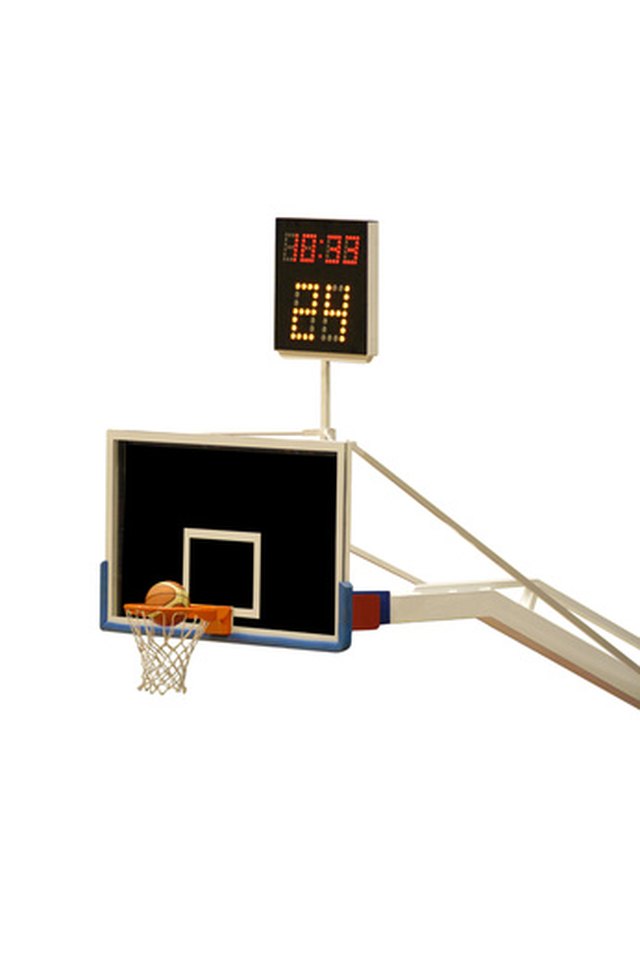How to Start a Basketball Clock After Free Throws

Many people enjoy watching basketball games because of its fast-paced action. Scoring happens frequently, and the ball moves quickly up and down the court, often at a frenetic pace. For clock officials, keeping accurate track of the time can be a challenge, especially during stops in play. Knowing when to stop and start the clock during free throws in particular requires a good understanding of the rules of the game, and thinking ahead of the variety of scenarios that take place during free throw attempts.
Stop the clock when the referee blows the whistle for a foul. Free throws occur after the referee calls a personal foul -- but do not happen after every foul. The other times free throws occur are when referees call technical fouls against specific players, the bench or a coach for some form of unsportsmanlike conduct.
Observe if, in fact, the foul results in a free throw situation. If the team committing the foul has a certain number of team fouls for the half, usually seven, the other team gets to shoot a one-and-one free throw -- if the offensive player was not in the act of shooting, in which case there would be two free throws. A one-and-one _ also referred to as a one-plus-one situation -- means the shooter gets one free throw. If he makes it he gets another free throw. If he misses the first free throw, the action is live.
Start the clock in a one-and-one free throw situation if the first shot misses and hits the rim. Wait to start the clock, however, until any player touches the ball. If the shooter misses the free throw and the ball does not touch the rim, the referee will blow the whistle and give the ball to the opposing team. Start the clock after the team throws the ball inbounds and a player touches the ball.
Hold the clock if the shooter makes the first free throw in a one-and-one situation. Start it on the second free throw if the shot misses and hits the rim when a player touches the ball. If the player makes the second free throw, start the clock after the opposing team throws the ball inbounds and a player touches the ball. Again, if the second free throw misses the rim entirely, the referee will blow the whistle and award the ball to the opposing team. Start the clock after the ball touches a player after being thrown inbounds.
Hold the clock on the first free throw if the referee calls for two free throws. Two free throws are called if either the player was in the act of shooting when fouled or the team is in what is called a double bonus, or penalty, situation. This means the opposing team, in most levels before professional, has committed at least 10 team fouls in the half. At that point, all free throws become two free throws. Start the clock when the second free throw misses and hits the rim, and touches a player. Start the clock when the second free throw either goes in or misses the rim entirely only after the ball touches a player after being thrown inbounds from the opposing team.
Hold the clock for the first two free throws on the rare occasions when three free throws are awarded by the referee. Three free throws are given when a shooter attempts a three-point shot and is fouled during the act of shooting and misses the shot. Follow the same rules on the third free throw as you would for a second free throw on one-and-one and two-shot situations.
Hold the clock during the whole free-throw process if a technical foul is called. Only the shooter will be on the free throw line with all other players on the court behind the free throw shooter. The clock remains stopped until the ball touches a player on the ensuing inbounds play..
Tips
Familiarize yourself on clock management and officiating rules if you plan on running the clock and scoreboard for an organized basketball game.
References
Tips
- Familiarize yourself on clock management and officiating rules if you plan on running the clock and scoreboard for an organized basketball game.
Writer Bio
Greg Stone began writing professionally for various websites in September of 2010. He lives in Branson, Mo. and is the marketing director for Doulos Discipleship of Doulos Ministries. Stone holds a Bachelor of Science in journalism from Central Missouri University and a Master of Ministry from John Brown University.
